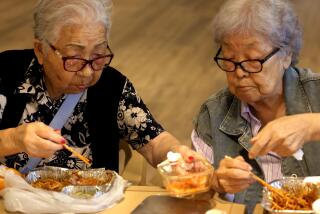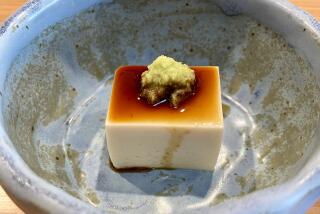Nisei Week : Little Tokyo Festival Forges East-West Link
A Shinto priest dressed in a purple skirt, white silk robe and high black hat whisked a stick holding white paper tassels through the air in a centuries-old purification rite, then offered a prayer in classical Japanese and English.
âPrincipal parent of this great and vast universe . . . we choose this day to purify, to dedicate and to officially open this festival,â intoned Alfred Y. Tsuyuki, head minister of the Konko Church of Los Angeles. âLet the Nisei Week pageant continue to . . . bridge the gap between Eastern and Western cultures, traditions and people.â
With that ceremony Wednesday evening at the Little Tokyo Square shopping mall, the 46th annual Nisei Week Japanese Festival was formally begun. Major activities begin today and run through next weekend, with Little Tokyo becoming the site of dozens of cultural exhibits, sports events and fine arts performances that showcase present-day Japanese-American culture and provide a taste of traditional Japan. Organizers expect about 50,000 people--roughly half of them non-Japanese--to attend the various events.
Deep Roots
The festival also links disparate groups among the approximately 150,000 ethnic Japanese living in the Los Angeles area, who are divided socially and linguistically between Japanese-Americans with deep roots in the United States and newcomers from Japan, including recent immigrants and businessmen living here temporarily.
âNisei Week provides a mechanism for both the new Japanese from Japan--the highly economically successful Japanese--as well as the Japanese-Americans to come together, talk, learn, argue, discuss, whatever they want, and come to some mutual understanding,â Tsuyuki, a third-generation Japanese-American, said in an interview. âIt is a unifying experience.â
The multifaceted nature of Nisei Week is reflected in the Grand Parade to be held at 4 p.m. on Sunday.
Leading the parade will be about 500 kimono-clad ondo folk dancers, followed by eight marching bands, open cars carrying dignitaries and 18 floats, including one for the Nisei Week queen and her court.
The queen will be selected this evening at a Coronation Ball at the Beverly Hilton.
A large majority of the dancers and the volunteer organizers are Japanese-Americans, while Japanese corporations, such as trading companies, automobile manufacturers and banks, sponsor many of the floats and help cover other festival costs.
The local subsidiaries of these firms âfeel that if they help the local community, step by step they can become part of the local community,â said Mitsuhiko Ito, general chairman of this yearâs festival, who was sent to Los Angeles by the Matsuzakaya department store chain to run its Little Tokyo store.
Itoâs selection as general chairman marked âa conscious effort . . . to bring the two parts of the community closer together,â said Katsumi Kunitsugu, executive secretary of the Japanese American Cultural and Community Center.
Hearkens Back
âFor the Japanese from Japan--the people stationed here for their companies--the festival hearkens back to the summer festivals of Japan,â Kunitsugu added. âBut it has a definite Japanese-American slant to it, of course, and itâs not exactly like a Japanese festival in Japan.
âWe have the floats, beauty queen and marching bands. Those would be the American touches. Then the Japanese touches would be the taiko drummers, the ondo dancers. Itâs kind of a hodgepodge.â
The ondo dancing has its roots in Japanâs traditional summer Obon festival, Kunitsugu said.
âThatâs the Buddhist festival of the dead,â she explained. âIt means that once a year, the spirits of your dead relatives and ancestors come back and visit the living. Itâs a time of reunion, so itâs a joyous time, not a sad time.â
Bruce Kaji, a Little Tokyo banker and president of the Japanese American National Museum foundation , said Nisei Week âgives everybody an opportunity to come out and see old friends and see the exhibits.â
âThey show the tea ceremony, exhibits on bonsai, flower arrangements--all of these things are very good and continue the appreciation of cultural arts,â Kaji said. âThe older people really appreciate that. For the younger people, I think it gives them a chance to appreciate their roots and some of the better things of the Japanese tradition brought over to the United States and carried on.â
âOld Cultureâ
Tim Itatani, 32, a fourth-generation Japanese-American who works as a corporate management consultant, said for many younger Japanese-Americans, Nisei Week provides an opportunity to find relaxation and revitalization by exploring âthe old culture.â
âFor the fourth generation--most of those I know--itâs very difficult for us to know the culture at all,â Itatani said. âWe have as much difficulty pronouncing the words as anybody else.
âOur grandparents were born here. But for those 10 days, at least we have a chance to learn Japanese words and see the dancers. You have a chance to get involved in the culture and learn about things you arenât involved with the rest of the year.â
Nisei Week was first held in 1934, broken off during World War II and then resumed in 1949. It was conceived amid the Depression as a way of boosting business for Little Tokyo merchants, as well as celebrating Japanese-American culture and providing the pioneer Issei generation nostalgic reminders of Japan.
âAt that time, the second generation was coming into its own, and feeling its oats,â Kunitsugu said. âThe emphasis was on the Nisei coming of age. . . . Itâs something started by the second generation--the Nisei--and thatâs why itâs still called Nisei Week.â
Cast Votes
In the early days, customers acquired the right to cast votes for Nisei Week queen by making purchases at Little Tokyo stores--a system favoring candidates from wealthier families that was later abandoned.
Kansuma Fujima, who choreographed three of the folk dances that will be part of this yearâs festival, recalled that the praise of friends during the 1934 Nisei Week ondo dancing helped inspire her to go to Japan to study Japanese classical dance during the next four years.
âThey said, âOh, youâre just terrific,â â Fujima said. âI thought, if I can make people so happy, Iâd better go to Japan and really learn it. Thatâs how I got started.â
After returning from Japan, Fujima founded the Fujima Kansuma Kai dancing school. In one of the highlights of this yearâs Nisei Week, performers from the school will present Kabuki dances at 1:30 and 7:30 p.m. next Saturday at the Japan America Theatre.
Cultural exhibits will be at various locations, many of them at the Japanese American Cultural and Community Center, 244 S. San Pedro St., one of the places where brochures will be available listing the times and locations of all events.
Race Planned
Sports events include karate tournaments at 6 p.m. today and 6 p.m. next Saturday, a five-kilometer run starting at 8 a.m. Sunday and a bicycle race at 8 a.m. Aug. 17.
âYankee Samurai,â a film documenting the history of Japanese-Americans, including the World War II battles of American Nisei soldiers in Europe, will be shown at 11 a.m., 1 p.m., 3 p.m. and 5 p.m. today at the Japan America Theatre.
On both Saturday and Sunday of next weekend, there will be a street arts festival and carnival with food and games.
At 4 p.m. Aug. 17, as the festival draws to a close, the streets will fill again with ondo dancers performing both traditional steps and one of Fujimaâs new creations, the âNadeshiko Ondo,â named after a Japanese flower.
Fujima said the other dances she choreographed stress lively steps or the noise of the naruko , a kind of clacking instrument, but the âNadeshiko Ondoâ has a softer feeling.
More to Read
Sign up for Essential California
The most important California stories and recommendations in your inbox every morning.
You may occasionally receive promotional content from the Los Angeles Times.










